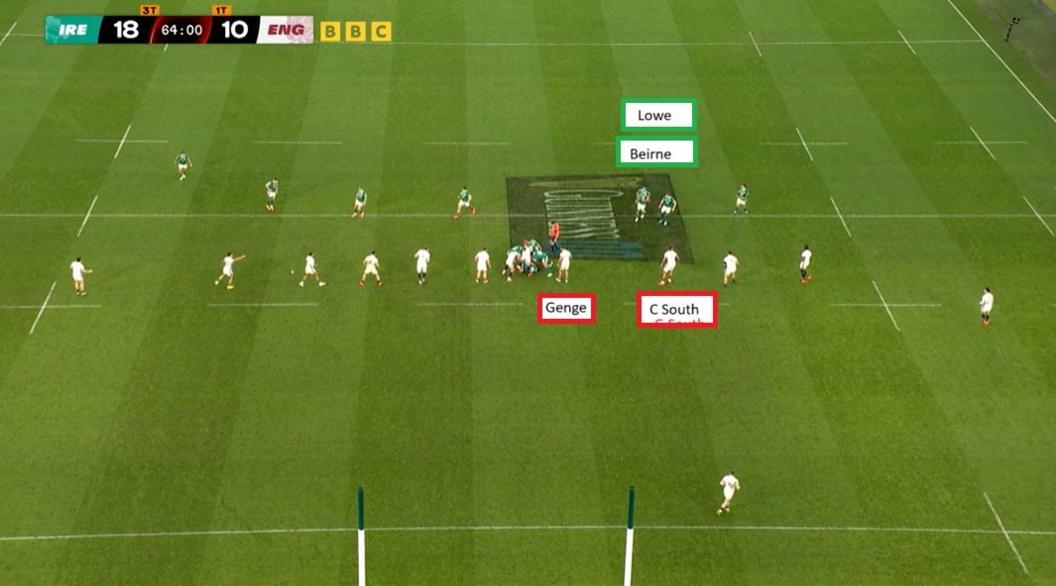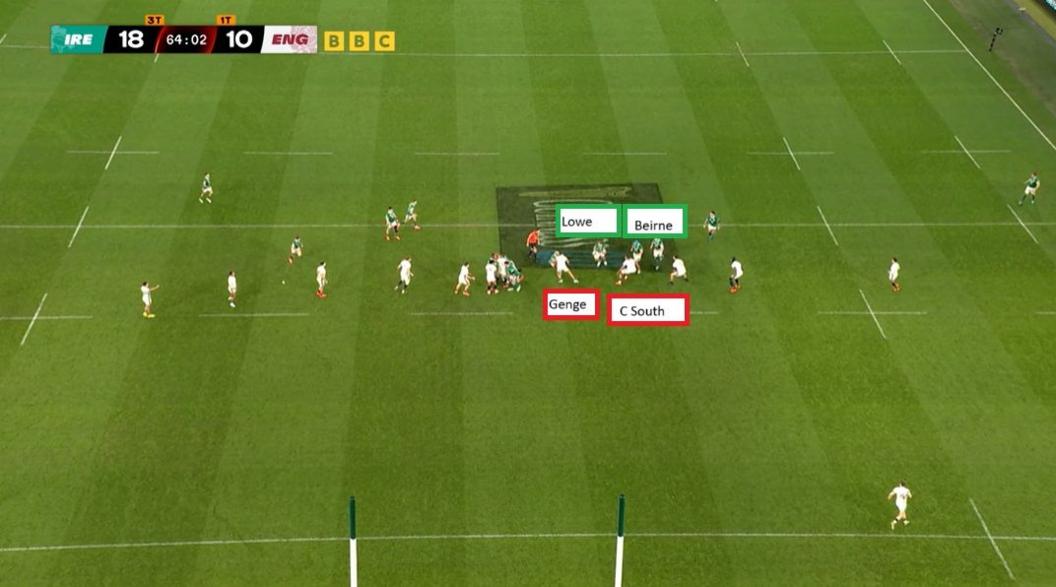
Six Plays That Defined the 2025 Six Nations
Key Moments That Shaped the 2025 Six Nations Championship
The 2025 Six Nations Championship provided some of the most exciting rugby in recent memory, with a total of 101 tries scored across 15 thrilling matches. While the competition showcased the brilliance of individual players, it was the collective team efforts that made this year’s tournament so memorable. With defences becoming more sophisticated, and with new rules and energy dynamics shaping play, the attack remained a constant driving force. Here, we’ll look at six key moments that defined the championship, highlighting the tactics and the players who left an indelible mark on the Six Nations.
Ireland’s Intricate Playbreaks English Resistance in the Opening Round

Screenshot of Ireland’s try against England
Ireland, under the guidance of head coach Andy Farrell, has long been known for its tactical sophistication and intricate play-making. Despite more pressure being placed on teams’ defences this year, Ireland’s attention to the small details of their game remained a standout feature. One play from the opening round against England is a perfect example of how precision and timing can break even the toughest defences.
In a finely orchestrated move, wing James Lowe tucked himself behind Tadhg Beirne at the breakdown, creating confusion for the English defence. As Jamieson Gibson-Park picked up from the base of the ruck, Lowe darted around to the open side, leaving Chandler Cunningham-South of England lost in the shuffle. Beirne continued his run to receive the final pass and score. This move, a reflection of Ireland’s style, epitomized their game plan throughout the Six Nations: precise, deceptive, and difficult to counter.
However, Ireland’s tactics would face significant challenges in the later rounds, particularly against France, where their meticulous plans were disrupted by France’s formidable power and speed. The Six Nations has always been about the evolution of rugby, and Ireland faces the challenge of maintaining their intricate style while incorporating new strategies in the coming years.
Smith Steps Up to Halt England’s Slide

England’s winning try against France
England, under coach Steve Borthwick, faced a difficult period in the Six Nations, including a disappointing defeat to Ireland in the opening round. As they trailed France by six points in their second match, a sense of desperation began to set in. With time running out, a loss would have seen England extend their losing streak against top-tier teams, placing even more pressure on Borthwick.
Enter rookie fly-half Fin Smith, whose composure and brilliant tactical play helped England salvage their match. With less than a minute remaining, Smith orchestrated a perfectly timed move that saw wing Elliot Daly receive a delayed pass. The ball flowed through England’s backline, with Ollie Lawrence and Tommy Freeman creating space by fixing France’s centre pairing of Yoram Moefana and Pierre-Louis Barassi. Smith’s precise execution of the pass helped Daly break through the defence, giving England a crucial victory and denying France the chance to secure a Grand Slam.
This moment demonstrated the power of quick thinking and perfect execution, and it was Smith’s moment to shine on the Six Nations stage.
Antoine Dupont Brings a New Dimension to France’s Play

He’s back! Dupont magic leads to first try of Six Nations
One of the standout players of the Six Nations was France’s scrum-half Antoine Dupont, who once again reminded everyone of his brilliance. While he did have a couple of rare mistakes during the tournament, such as a misjudged pass against England, his genius was evident throughout. Dupont’s ability to influence the game with his kicking, vision, and quick decisions gave France a significant edge.
One of the most memorable plays came during France’s tournament opener against Wales. After a series of powerful phases from the forwards, Dupont pulled off a play that caught the Welsh defence off guard. As Dupont took the ball from the breakdown, he momentarily looked backward, drawing the Welsh defenders forward before executing a chip kick to the far wing. The pass found Theo Attissogbe, who capitalized on the opportunity to score. This kick-pass tactic, executed to perfection, is something that sets Dupont apart from other players, and it allowed France to break through the defensive lines in a way no other team could replicate.
Dupont’s brilliance was not just in attack, but also in defence, as France used similar tactics during the tournament to gain territory and create attacking opportunities. His contributions were pivotal in ensuring France’s place among the tournament’s top contenders.
Scotland’s Creative Attack and Stylish Rugby

Screenshot of Scotland try against Wales
Scotland finished fourth in the final standings, but their attacking style and creative rugby won them many admirers. Despite missing injured captain Sione Tuipulotu, Scotland played an expansive game, focusing on width and flair. Their ability to carry the ball and pass it across the field was one of the highlights of the tournament, with the Scots finishing as the team with the most passes and the most meters carried.
One of the most memorable tries came in their win over Wales. With the ball recycled from a breakdown on the left touchline, the forwards offered a decoy option, allowing fly-half Finn Russell to throw a long pass to Blair Kinghorn. The play then opened up space as Darcy Graham’s agility and Duhan van der Merwe’s power combined to create opportunities. Van der Merwe’s strength allowed Huw Jones to get the ball wide, and Scotland’s fast-moving backline found space to exploit. It was a superb display of team work, fluidity, and individual brilliance.
Despite lacking the power and depth up front compared to other nations, Scotland’s attacking flair, creativity, and understanding of open space were their strongest weapons. Their performance in the Six Nations proved that, with the right combination of athleticism and tactical awareness, Scotland could compete with the best in the world.
Ramos’ Instinctive Interception Seals the Deal for France
In the crucial match between Ireland and France, the tactical battle was intense, with both sides desperate for a win. At one point, Ireland looked to be staging a late comeback, and their attack was pressing France hard. However, full-back Thomas Ramos showcased his instincts and rugby intelligence in a key moment that defined the game.
As Ireland came within five meters of France’s try line, Ramos sensed an opportunity. Despite Ireland having the advantage of a one-man overlap, Ramos charged up from the line and intercepted a pass from fly-half Sam Prendergast. With a quick burst, Ramos raced downfield and delivered a perfectly timed pass to Damian Penaud, who finished under the posts. The interception, which could not be practiced, showed Ramos’ rugby instinct and was a decisive moment in France’s victory.
This moment demonstrated the importance of playing what is in front of you and seizing opportunities when they arise, even under intense pressure.
Maro Itoje’s Leadership and Diplomacy
While the Six Nations is often remembered for dazzling tries and tactical brilliance, England’s lock Maro Itoje showed that leadership and diplomacy are also crucial in high-stakes matches. Throughout the tournament, Itoje was vocal and influential, particularly when it came to managing referee decisions.
In England’s clash with Ireland, a contentious decision led to the hosts scoring a try. Itoje, who had been held at the breakdown by Beirne, diplomatically engaged with the referee, Ben O’Keeffe, and successfully had the try ruled out. Later in the tournament, during England’s match against Scotland, Itoje was once again present, making sure to communicate effectively with the referee, influencing key decisions, and ensuring that England’s interests were well-represented.
Itoje’s ability to remain calm and composed in such situations highlighted his leadership qualities. As England look toward the 2025 British and Irish Lions tour, his diplomatic skills may very well position him as a key figure for the Lions, further cementing his place as one of the best locks in the world.
Conclusion: A Championship for the Ages
The 2025 Six Nations Championship was a showcase of individual brilliance, tactical mastery, and thrilling rugby action. From Ireland’s intricate attacking moves to France’s exciting kicking game, Scotland’s flair, and England’s resilience, the tournament offered fans countless memorable moments. Whether it was Antoine Dupont’s dazzling kicks, Thomas Ramos’ crucial intercepts, or Maro Itoje’s leadership, this year’s Six Nations lived up to its reputation as one of the premier rugby events on the international calendar.






































There are no comments yet. Be the first to comment!